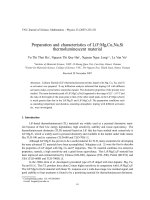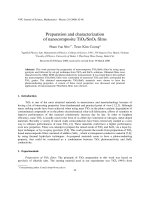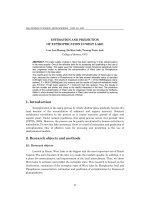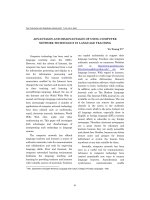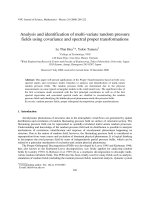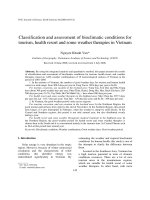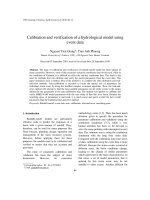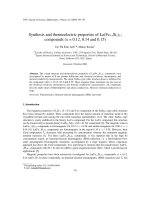Báo cáo " Synthesis and characterisation of metallic nanoparticles " ppt
Bạn đang xem bản rút gọn của tài liệu. Xem và tải ngay bản đầy đủ của tài liệu tại đây (436.7 KB, 10 trang )
VNU Journal of Science, Mathematics - Physics 25 (2009) 221-230
221
Synthesis and characterisation of metallic nanoparticles
Nguyen Hoang Luong
1,
*, Nguyen Ngoc Long
1
, Le Van Vu
1
, Nguyen Hoang Hai
1
,
Luu Manh Quynh
1
, Phan Tuan Nghia
2
, Nguyen Thi Van Anh
2
1
Center for Materials Science, Hanoi University of Science, Vietnam National University, Hanoi
334 Nguyen Trai, Thanh Xuan, Hanoi, Vietnam
2
Key Laboratory for Enzyme and Protein Technology, Hanoi University of Science,
Vietnam National University, Hanoi, 334 Nguyen Trai, Thanh Xuan, Hanoi, Vietnam
Received 2 December 2009
Abstract. Sphere-like gold nanoparticles have been prepared by chemical reduction method and
by using X-ray irradiation, while rod-like gold nanoparticles were synthesized according to the
seed-mediated growth method and by sonoelectrochemistry. Sphere-like gold nanoparticles have
diameter of 20 - 60 nm, while rod-like gold nanoparticles have aspect ratio from 2 to 4. In UV-vis
spectra the absorption bands related to surface plasmon resonance were observed. CoPt
nanoparticles with the size of 5 - 20 nm have been prepared by electrodeposition, while FePt
nanoparticles with the size of 5 - 10 nm were synthesized by sonoelectrodeposition. After
annealing, these magnetic nanoparticles showed a high coercivity. The metallic nanoparticles were
functionalized for trial of application in biomedicine.
Keywords: Gold nanoparticles, CoPt nanoparticles, FePt nanoparticles, Optical properties,
Magnetic properties.
1. Introduction
Metallic nanoparticles (NPs) are very attractive because of their size- and shape-dependent
properties (see, for instance, [1]). For example, gold nanospheres have a characteristic red colour, but
anisotropic gold nanorods have a changed dramatically colour. The colour is due to the collective
oscillation of the electrons in the conduction band, known as the surface plasmon oscillation [1,2]. The
oscillation frequency is usually in the visible region for gold (and silver) giving rise to the strong
surface plasmon resonance absorption. The plasmon resonance absorption has an absorption
coefficient orders of magnitude larger than strongly absorbing dyes, leading to increased detection
sensitivity. Thus many applications in biomedicine of gold NPs became possible. Magnetic NPs based
on transition metals Co, Fe… such as CoPt, FePt… have very high potential application in producing
new-generation ultra-high-density magnetic recording media because of their good chemical stability
and high magnetocrystalline anisotropy observed in the ordered intermetallic phase with L1
0
structure
(see, for instance, [3,4]). These materials will contribute to an effort to design a magnetic medium
capable of recording densities beyond 1 Tbits/in
2
. Beside, these materials have potential applications
in permanent magnetic nanocomposites and biomedicine.
______
*
Corresponding author. Tel: (84-4) 38584287, E-mail:
N.H. Luong et al. / VNU Journal of Science, Mathematics - Physics 25 (2009) 221-230
222
In this paper, we report on synthesis and characterization of gold NPs as well as CoPt and FePt
NPs.
2. Experimental
Synthesis of gold nanospheres using chemical reduction method was carried out as follows: 50 ml
of 0.01 wt% chlorauric acid (HAuCl
4
.3H
2
O) solution was heated to boiling while stirring in a 100 ml
beaker. Then a few hundred microlitres (μl) of 1 wt% trisodium citrate dihydrate (Na
3
C
6
H
5
O
7
.2H
2
O)
solution was quickly added to the auric solution. The solution changed colour within several minutes
from yellow to black and then to red or purple colour depending on the size of the nanoparticles. Gold
nanospheres were also synthesized using a stronger reductive agent (sodium borohydride (NaBH
4
)) as
follows: 5 ml NaBH
4
0.01 M at 0
o
C was added to 25 ml HAuCl
4
1 mM in 50 ml flask with stirring for
15 min, until the colour of the solution changed from lightly yellow to dark red.
Gold NPs were also synthesized via a photochemical approach by using X-ray irradiation. A few
μl of 1 mM triton X-100 (TX-100) solution was mixed with 3 ml of 1 mM HAuCl
4
.3H
2
O solution.
Pure HAuCl
4
solution without TX-100 addition was also prepared for comparison. The X-ray radiation
was Cu-Ka radiation of an X-ray diffractometer Brucker D5005 with the parameters of 40 kV and 40
mA. The X-ray irradiation time was set up to 40 or 60 min to guarantee the complete reduction of gold
precursor solution.
Gold nanorods have been synthesized according to the seed-mediated growth method consisting of
two steps.
Step 1: Preparation of seed solution: 2.5 ml of 1 mM chlorauric acid solution was mixed with 7.5
mL of 0.2 M cetyltrimettyammonium bromide (CTAB: C
19
H
42
BrN) solution and stirred. 0.6 mL of
ice-cold 0.01 M sodium borohydride (NaBH
4
) solution was added to the stirred solution. The final
solution had a brownish yellow colour. After stirring the seed solution for 2 min, the seed solution was
kept at room temperature (RT).
Step 2: Growth of nanorods: 5 ml of 0.2 M CTAB solution was added to 5 ml of 1 mM chlorauric
acid solution. Then a few hundred μl of 4 mM silver acetate (AgC
2
H
3
O
2
) solution was added and
gently mixed. After that, to this solution, 70 μl of 0.08 M ascorbic acid (C
6
H
8
O
6
) solution and 12 μl of
the seed solution were added. By changing the amount of silver acetate, the aspect ratio (AR) defined
as the length of the major axis divided by the width of the minor axis of the nanorods can be varied.
To separate nanorods from nanospheres, the solution was centrifuged at 3000 rpm for 10 min.
Gold nanorods were also synthesized from metallic gold by sonoelectrochemical technique. A gold
metal plate (1 cm × 1 cm × 0.05 cm) was used as the anode and a platinum plate (1 cm × 1 cm × 0.05
cm) was used as the cathode. These two electrodes were placed in a glass containing 25 ml of
electrolytic solution consisted of 0.08 M CTAB and 83 mg tetradodecylammonium-bromide (TCAB).
2 ml of acetone and 1 mL of cyclohecxan were added into the above mixed solution prior to
electrolysis. Then the glass with the electrolytic solution was putted to an ultrasonic bath
(ULTRASONIC LC 30H) and ultrasonicated throughout the electrolysis time.
CoPt NPs were synthesized by electrodeposition method. The electrolytes were composed of 0.1
M/l CoCl
2
.6H
2
O, 0.01 M/l H
2
PtCl
6
, and 0.525 M/l Na
2
SO
4
, contained in a 100 ml three-neck flash.
The pH of 3 of the electrolyte was adjusted by H
2
SO
4
. Poly(vinyl-pyrrolidone) (PVP) with molecule
weight of 30,000 as a surfactant was added. Before starting electrodeposition, nitrogen gas was
bubbled in the electrolyte for 20 min to remove the amount of dissolved oxygen. Electrodeposition has
N.H. Luong et al. / VNU Journal of Science, Mathematics - Physics 25 (2009) 221-230
223
been conducted ganvanostatically in a two electrode home-made cell at RT. A platinum plate with a
square of 1 cm
2
was used as a counter electrode. A titanium cathode has the same area. Current pulse J
was changed from 13 to 40 mA/cm
2
. The duration of the current pulse was 0.5 s then the current was
turned off for a fixed duration of 0.3 s. The electrodeposition was carried out under nitrogen
atmosphere. After 1 h deposition, a black solution was obtained and as-prepared nanoparticle powder
was collected by using centrifuging at 9000 rpm for 30 min. The powder was annealed at 700°C for 1
h under a mixture of 5 % H
2
and 95 % Ar atmosphere. The increasing rate of temperature was 6°C/min
and cooling with the furnace.
The sonoelectrodeposition method has been used for synthesis of FePt NPs. The
sonoelectrodeposition device employed is similar to that described in ref. [5]. A titanium horn with
diameter of 1.3 cm acted as both the cathode and ultrasound emitter (Sonics VCX 750). The
electroactive part of the sonoelectrode was the planar circular surface at the bottom of the Ti horn.
This sonoelectrode produced a sonic pulse that immediately followed a current pulse. A platinum plate
with a square of 1 cm
2
was used as a counter electrode. The current pulse was changed from 15 to 30
mA/cm
2
. The ultrasound power density was 100 W/cm
2
. The duration t
on
of the current pulse was 0.5 s
then the current was turned off for a fixed duration of 0.5 s. During t
on
, FePt NPs were deposited on
the surface of the electrode. When the current was switched off, an ultrasound was activated to remove
the NPs from the electrode. The time of ultrasound was 0.2 s for all samples. The temperature during
the reaction was room temperature. After deposition, FePt NPs were collected by using a centrifuge
(Hettich Universal 320) at 9000 rpm for 20 min. NPs were dried in air at 80°C for 20 min. All samples
were annealed at 700°C for 1 h under H
2
atmosphere.
The obtained NPs were characterized by X-ray diffraction (XRD) by using a Brucker D5005
diffractometer and transmission electron microscopy (TEM) by using a JEOL JEM1010 electron
microscope. UV-vis absorption spectra of the nanoparticle solutions were collected with a Shimadzu
UV 2450 PC spectrometer. The chemical composition of the CoPt and FePt NPs was studied by using
an energy dispersion spectroscopy (EDS OXFORD-ISIS 300). Magnetic measurements were
performed by using a DMS-880 sample vibrating magnetometer (VSM) with maximum magnetic field
of 13.5 kOe at RT.
3. Results and discussion
Gold nanoparticles
Figure 1 shows a typical XRD pattern of the gold NPs obtained from the solution with 400 μl of
trisodium citrate solution. It can be seen from the figure that all the diffraction peaks corresponding to
the diffraction planes (111), (200) and (220) were indexed to the gold metal with face-centered cubic
(fcc) structure. Lattice constant determined from XRD pattern is a = 4.078 Ǻ, in good agreement with
the standard diffraction pattern of cubic gold metal (Pattern 4-784) [6].
Surface plasmon absorption spectra of spherical gold NPs prepared with different amounts of 1 %
trisodium citrate solution are shown in figure 2. As seen from the figure, the maximum of the
absorption spectrum is shifted to the short wavelength side (from 539.9 nm to 521.1 nm) and the full
width at half maximum (FWHM) of the spectrum is decreased with increasing amount of trisodium
citrate from 200 μl to 400 μl. Thus, the amount of citrate solution determines the size of the NPs. The
faster the capping of the NPs by the citrate, the smaller the resulting NPs.
N.H. Luong et al. / VNU Journal of Science, Mathematics - Physics 25 (2009) 221-230
224
Typical TEM images of the gold NPs prepared with different amounts of 1 % trisodium citrate
solution are shown in figure 3. From the figure one can see that when the amount of trisodium citrate
increases from 200 μl to 400 μl, the size of the synthesized gold NPs decreases from 60 nm to 30 nm.
That means the more amount of trisodium citrate, the smaller obtained NPs.
Gold NPs were also synthesized via a photochemical approach by using X-ray irradiation as
mentioned above. The TEM image [6] showed that the addition of TX-100 behaving as a particle
stabilizer and reducing agent into HAuCl
4
solution tremendously affected the formation and growth of
the gold NPs.
Gold nanorods were synthesized according to the seed-mediated growth method with two steps.
TEM image of gold NPs for the as-prepared sample (not shown) showed that two major components
of the sample are spherical NPs and nanorods. After centrifugation at 3000 rpm for 10 min, the
nanorods were separated from spherical NPs.
Surface plasmon absorption spectra of anisotropic gold nanorods prepared with different amounts
of 4 mM silver acetate solution are shown in figure 4. As seen from the figure, when the shape of the
NPs changes from nanospheres to nanorods, the surface plasmon absorption spectra also change. The
surface plasmon absorption spectra of the gold nanorods have two bands: one band in the blue-green
Fig. 1. XRD pattern of the gold NPs
prepared by chemical reduction technique.
Fig. 2. Surface plasmon absorption spectra of spherical gold
NPs prepared with different amounts of 1% trisodium citrate
solution: 200, 240, 280, 320, 360 and 400 μl.
Fig. 3. TEM images of the gold NPs prepared with different amounts (200, 280, 360 and 400 μl) of 1 %
trisodium citrate solution. All the scale bars are 100 nm. On the pictures are shown the size of the NPs and the
wavelength of the maximum of surface plasmon absorption spectra.
200 μl
60 nm
540 nm
280 μl
50 nm
536 nm
360 μl
40 nm
529 nm
400 μl
30 nm
521 nm
N.H. Luong et al. / VNU Journal of Science, Mathematics - Physics 25 (2009) 221-230
225
region around 525 nm due to the transverse oscillation of electrons and another band in the red-
nearinfrared region due to the longitudinal electronic oscillation. In addition, the position of the band
due to the transverse electronic oscillation is almost unvaried; meanwhile with increasing the silver
acetate content from 70 μl to 120 μl, the position of the band due to the longitudinal oscillation is
increased from 654 nm to 830 nm, which corresponds to the enhance of the aspect ratio (AR) of the
gold nanorods.
Gold nanorods were synthesized from metallic gold by sonoelectrochemical technique as well [7].
Typical TEM images of the gold nanorods shown in figure 5 indicate that the nanorods are of
uniform size. The AR distribution histogram presented in the inset of figure 5 shows that the size of
nanorods has a narrow distribution: the nanorods having the AR of 3 make up 55% and those having
the AR of 4 make up 25%.
CoPt nanoparticles
Before annealing, the XRD patterns for CoPt NPs (not shown) showed the reflections of pure Pt
structure, which is similar to other CoPt thin films produced by electrodeposition [8]. The reflections
from Co are very weak due to the fact that their atomic weight is much less than that of Pt. The Pt
peaks in the as-prepared samples are broad due to the small size of the particles. The as-prepared
particles were not disordered CoPt but they were formed by many Co-rich and Pt-rich small particles.
Using the Scherrer formula with the FWHM of the strongest peak (111), the mean particle size of the
particles was deduced to be 6 nm.
The positive Pt
4+
and Co
2+
ions went to the cathode surface and received electrons to make Pt and
Co NPs. If there was not PVP surfactant, Co and Pt atoms would continously deposited on the
particles and at the end we would have a film of CoPt. The presence of PVP around NPs created a
steric forces that limit the growth of NPs and we could obtained Co and Pt NPs well dispersed in the
solution.
Fig. 4. Surface plasmon absorption spectra
of the gold nanorods prepared with
different amounts (70, 80, 100 and 120 μl)
of 4 mM silver acetate solution.
Fig. 5. TEM images of the gold nanorods prepared by
sonoelectrochemical method. Inset is an aspect ratio
distribution histogram.
012345678
0
10
20
30
40
50
60
Frequency (%)
Aspect ratio
N.H. Luong et al. / VNU Journal of Science, Mathematics - Physics 25 (2009) 221-230
226
Figure 6 are the TEM images of typical as-prepared and annealed samples. Particle size of the as-
prepared CoPt sample was about 5 nm, which is consistent with the size obtained from the broad XRD
peaks. Particle size (5 - 20 nm) depends on the concentration of PVP (1 to 5 g/l). After annealing the
particle size increased to 100 nm due to the diffusion and aggregation between particles to form face-
centered tetragonal (fct) CoPt NPs.
Fig. 6. TEM images of the as-prepared (left) and annealed (right) Co-Pt NPs.
Magnetic measurements revealed low saturation magnetization (M
s
) and coercivity (H
c
) in all as-
prepared samples (data not shown). The low value of M
s
of the as-prepared NPs may be explained by
the oxidation or hydroxidation of Co atoms in NPs which can result in the antiferromagnetic cobalt
oxides and weak magnetic cobalt hydroxides. This is in agreement with the suggestion of separated Co
and Pt domains in as-prepared NPs. After annealing the hard magnetic CoPt phase was formed. Figure
7 presents the magnetic curves of the annealed samples with current density J of 13, 20, and 40
mA/cm
2
. The curves for J of 15, 25, 30 mA/cm
2
(not shown) are similar to that of 20 mA/cm
2
. The
curves show typical hard magnetic hysteresis loops of multiphase materials with high H
c
. (For H
c
in
the multiphase materials the reader is referred to discussion below for FePt NPs). Coercivity gets
maximum value (around 11 kOe) in the samples with the chemical composition of the particles close
to the equiatomic composition, i.e., samples with J of 15 to 30 mA/cm
2
. The atomic percent of Co
increased with J which resulted in the high M
s
. However, the magnetic squareness M
r
/M
s
reduced with
J because of the presence of the Co
3
Pt.
-10000-5000 0 5000 10000
-60
-40
-20
0
20
40
60
40 mA/cm
2
20 mA/cm
2
M (emu/g)
H (Oe)
13 mA/cm
2
Fig. 7. Magnetic curves for the annealed CoPt samples with J of 13, 20, and 40 mA/cm
2
.
N.H. Luong et al. / VNU Journal of Science, Mathematics - Physics 25 (2009) 221-230
227
FePt nanoparticles
The chemical composition of the FePt NPs was controlled by adjusting the current density
(corresponding to the applied voltage). With the current density J of 15 - 20 mA/cm
2
, the composition
of NPs was close to the expected equiatomic composition, namely for J of 15 mA/cm
2
and 20 mA/cm
2
,
Fe
45
Pt
55
and Fe
52
Pt
48
NPs were obtained, respectively . At higher current densities, the atomic percent
of Fe was higher because the standard electrode potential Fe
2+
/Fe (-0.44 V [9]) is more negative than
that of Pt
4+
/Pt (0.742 V [10]).
As in the case of CoPt NPs, before annealing, the XRD results (not shown) showed the reflections
of pure Pt structure, which is similar to other FePt thin films produced by electrodeposition [11]. Upon
annealing, the formation of the ordered L1
0
fct phase happened by the diffusion process between Fe
and Pt domains. The TEM images of typical as-prepared and annealed samples [12] showed that
particle size of the as-prepared FePt sample was 5 - 10 nm, compared to 5.2 nm obtained from the
XRD results by using the Scherrer formula. After annealing the particle size increased to 10 - 25 nm
due to the aggregation and particle growth.
Magnetic measurements revealed low M
s
and H
c
in all as-prepared samples (data not shown). For
the unannealed particles M
s
is about few emu/g and the coercivity is 20 - 80 Oe. The low value of M
s
of the as-prepared NPs may be explained by the oxidation or hydroxidation of Fe atoms in NPs which
can result in the weak magnetic iron oxides and iron hydroxides. This is in agreement with the
suggestion of separated Fe and Pt domains in as-prepared NPs.
After annealing the hard magnetic FePt phase was formed. Figure 8 presents the magnetic curve of
the annealed Fe
45
Pt
55
NPs as an example. The curve shows a typical hard magnetic hysteresis loops
with high H
c
. Note that, because of the limit of maximum applied field of 13.5 kOe, the curve is a
minor loop. Therefore, the real coercivity must be higher than those obtained from the hysteresis
curves. The loop shows a kink at low reversed magnetic field of 500 Oe, which indicates that there
was a small amount of a soft magnetic phase. Classically, the coercivity is defined as the field for
which the magnetization (M) vanishes (H’
c
). In a more physically meaningful definition, the coercivity
H
c
may be defined as the field where the largest number of moments reverses, i.e., the maximum of
the susceptibility (dM/dH). In most cases, both definitions of the coercivity are almost equivalent.
However in multiphase materials, two definitions are significantly different [13]. From Fig. 8, H’
c
was
6 kOe whereas H
c
was 8.5 kOe. Magnetic measurements for all samples show that the atomic percent
-10000 -5000 0 5000 10000
-30
-20
-10
0
10
20
30
0.000
0.002
0.004
0.006
0.008
0.010
M
M (emu/g)
H (Oe)
8500
6000
500
dM/dH
dM/dH (emu/g.Oe)
Fig. 8. Magnetic curves of
Fe
45
Pt
55
NPs
. The maximum applied field is 13.5 kOe.
N.H. Luong et al. / VNU Journal of Science, Mathematics - Physics 25 (2009) 221-230
228
of Fe increased with J which resulted in the high M
s
. However, the magnetic squareness M
r
/M
s
reduced with J because of the presence of the Fe
3
Pt.
Application of gold nanoparticles for detecting breast cancer cells
In order to detect breast cancer cells, we have conjugated the sodium borohydride (or sodium
citrate) reduced gold NPs with anti-Her2 antibody (trastuzumab) through either non-covalent or
covalent linkages. The procedure consists of the following steps [14]:
Functionalizing gold nanoparticles with 4-ATP (C
6
H
7
NS)
Different volumes of 4-ATP 2 mM were added into 20 ml of the gold NPs containing solution.
The colors of the solutions changed from dark red to dark blue, and then were incubated for 2 days.
Conjugation of trastuzumab to gold nanoparticles
Trastuzumab was non-covalently conjugated to colloidal gold NPs, prepared by NaBH
4
reduction
(named as BH
4
*GNPs). The colloidal gold suspension was adjusted by 0.1 M NaOH to pH 6.5 to react
with a mixture of 6 µg/ml non-labeled trastuzumab and FITC-trastuzumab (480 nm / 520 nm) at mole
ratio 10:1 at RT for 5 min. The trastuzumab-GNPs was collected by centrifugation at 4
o
C, at the rate
of 30,000 rpm, for 30 min. The pellets were washed twice and then resuspended in PBS with pH 7.4
containing 0.2 % bovine serum albumin (BSA). Trastuzumab was covalently linked to amino-GNPs
through EDC connection. Briefly, the above prepared amino-GNPs was reacted with EDC 0.2 mM in
MOPS buffer with pH 6.0, for 20 min. at RT. Then, the EDC*GNPs were reacted with 6 µg/ml non-
labeled trastuzumab and FITC-trastuzumab (480 nm / 520 nm) at mole ratio 10:1, for 30 min. at RT.
The trastuzumab-EDC*GNPs were washed three times by centrifugation at the rate of 13,000 rpm, at
4
o
C, for 13 min with PBS and then was stocked in PBS with pH 7.4 containing 0.2 % BSA.
The absorbance profile of trastuzumab-GNPs was measured and compared with that of GNPs
using Spectrophotometer (Nanodrop).
Culture of KPL4 and Hela cells
KPL4 and Hela cells were cultured in 24-well ELISA plates containing DMEM (Difco Modified
Eagle Medium) plus 10 % FBS (Fetal Bovine Serum). Glass coverslips were added in each well and
the cells were incubated at 37
o
C, 5 % CO
2
to reach a population of about 4×10
5
to 10
6
cells/ml. The
coverslips were picked out to new 24-well ELISA plate for further immuno-nanogold incubation.
Incubation of trastuzumab- conjugated gold NPs with KPL4, Hela cells and imaging of the cells
Coverslips containing KPL4 and Hela cells were washed 3 times with 500 µl PBS before being
fixed by 3 % paraformaldehyde at RT, for 15 min. and then treated with 5 % triton X-100 at RT for 5
min. After being blocked with 500 µl of 2 % BSA, the coverslips were incubated with 200 µl either of
trastuzumab-BH
4
*GNPs or trastuzumab-EDC*GNPs at a concentration of 3 µg/ml at RT, for 60 min.
The coverslips were observed under Axio Plan epifluorescence microscope (Carl Zeiss). The KPL4
cell incubated with Trastuzumab-EDC*GNPs were observed under FESEM (Field Emission Scanning
Electron Microscope).
We could observe the 10 times higher fluorescent intensity of FITC on KPL4 cells than that of
FITC on Hela cells in all the three types of trastuzumab-conjugated gold NPs. Because KPL4 is the
cell line having a high level of Her2-expression, while Hela is the cell line, which expresses Her2
normally, the remarkable difference in the fluorescent intensity between KPL4 and Hela indicates the
specific binding of all the three types of trastuzumab-GNPs on KPL4 membranes. However, among
the three types of the trastuzumab-conjugated gold NPs, the covalently linked trastuzumab-
EDC*GNPs showed to be the most stable in fluorescent intensity after a long time of stocking (several
months).
N.H. Luong et al. / VNU Journal of Science, Mathematics - Physics 25 (2009) 221-230
229
We also tried to conjugate the gold NPs with trastuzumab without FITC fluorescent dye. As seen
from figure 9, in the case of the GNPs non-conjugated with trastuzumab, the gold NPs could not find
the cancer cells and nothing was observed in the dark-field microscopy image (A
2
). When the gold
NPs were directly conjugated with trastuzumab, the gold NPs concentrated on the cancer cells and
these cancer cells were clearly observed in the dark-field microscopy image (A
4
) by means of
scattering light of the gold NPs. When the amino-GNPs were covalently conjugated with trastuzumab
through EDC connection, the gold NPs concentrated on the cancer cells as well, but these cancer cells
were observed with slightly lower intensity in the dark-field microscopy image (A
6
) in comparison
with those in the image A
4
. However, the gold NPs directly conjugated with trastuzumab were storable
in freezer for only about two weeks and then lost their activity; while the gold NPs covalently
conjugated with trastuzumab were stable for about two month storage.
Fig. 9. Typical bright-field (A
1
, A
3
, A
5
) and dark-field (A
2
, A
4
, A
6
) microscopy images of breast cancer cells
after incubation with the gold NPs non-conjugated with trastuzumab (A
1
-A
2
), the gold NPs conjugated with
trastuzumab (A
3
-A
4
) and the amino-GNPs covalently conjugated with trastuzumab through EDC connection
(A
5
-A
6
).
A
1
A
2
A
3
A
5
A
4
A
6
N.H. Luong et al. / VNU Journal of Science, Mathematics - Physics 25 (2009) 221-230
230
4. Conclusion
Gold NPs, CoPt and FePt NPs have been prepared. After annealing, CoPt and FePt NPs showed a
high coercivity. We succeeded in conjugating Trastuzumab to gold NPs for specific detection of Her2
over-expressed breast cancer cells, here is KPL4 cell line. Among 3 types of conjugation, the
covalently linked Trastuzumab-EDC*GNPs showed long-time stability and strong binding toward
breast cancer cell KPL4.
Acknowledgments. The authors would like to thank Ministry of Science and Technology of Vietnam
(Contract No 38/355/2008/HD-NDT for Task of Protocol with Israel) and Vietnam National
University, Hanoi (Key Project QGTD.08.05) for financial support. The authors are grateful to
Nguyen Duy Thien, Chu Dinh Kiem, Sai Cong Doanh, Nguyen Dang Phu of Center for Materials
Science, Hanoi University of Science, and Tran Thi Thanh Thoa of Key Laboratory for Enzyme and
Protein Technology, Hanoi University of Science for assistance.
References
[1] S. Eustis, M. A. El-Sayed, Chemical Society Review 35 (2006) 209.
[2] L. M. Liz-Marzan, Materialstoday 7 (2004) 26.
[3] Y. Huang, H. Okumura, G.C. Hadjipanayis, in: Magnetic storage systems beyond 2000, ed. G.C. Hadjipanayis, Kluwer
Academic Publisher, 2001, p. 171.
[4] S. Sun, Adv. Mater. 18 (2006) 393.
[5] J.J. Zhu, S.T. Aruna, Yu. Koltypin, A. Gedanken, Chem. Mater. 12 (2000) 143.
[6] Nguyen Ngoc Long, Le Van Vu, Chu Dinh Kiem, Sai Cong Doanh, Cao Thi Nguyet, Pham Thi Hang, Nguyen Duy
Thien, Luu Manh Quynh, Journal of Physics: Conference Series 187 (2009) 012026.
[7] Nguyen Duy Thien, Chu Dinh Kiem, Nguyen Ngoc Long, The 6th Vietnam National Conference on Solid State Physics
and Materials Science (SPMS-2009), Da Nang, Vietnam, 8-10 November, 2009.
[8] L. Zana, G. Zangari, J. Magn. Magn. Mater. 272-276 (2004) 1698.
[9] P. Atkins, Physical Chemistry, 6th edition, W.H. Freeman and Company, New York, 1997.
[10] A.J. Bard, L.R. Faulkner, Electrochemical Methods. Fundamentals and Applications, 2nd edition, John Wiley and Sons
Inc., 2001.
[11] Q. Zeng, Y. Zhang, H.L. Wang, V. Papaefthymiou, G.C. Hadjipanayis, J. Magn. Magn. Mater. 272-276 (2004) e1223.
[12] Nguyen Hoang Luong, Nguyen Hoang Hai, Nguyen Dang Phu, VNU Journal of Science, Mathematics - Physics 25
(2009) 1.
[13] D. Givord, M.F. Rossignol, Coercivity, in J.M.D. Coey (Ed.), Rare-earth Iron Permanent Magnets, Clarendon Press:
Oxford, 1996, p. 218.
[14] Luu Manh Quynh, Tran Quoc Tuan, Nguyen Ngoc Long, Nguyen Hoang Luong, Nguyen Hoang Hai, Tran Thi Thanh
Thoa, Nguyen Thi Van Anh, Phan Tuan Nghia, The International Workshop on Advanced Materials and
Nanotechnology (IWAMN2009), Hanoi, Vietnam, 24-25 November, 2009, to be published in e-Journal of Surface
Science and Nanotechnology.
